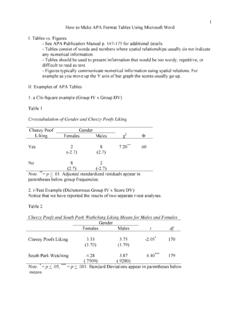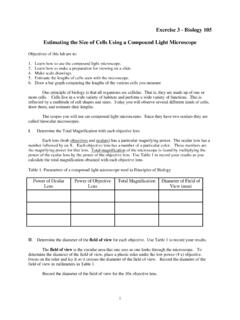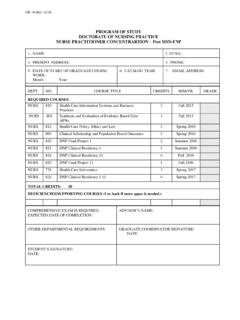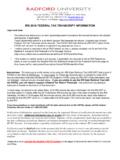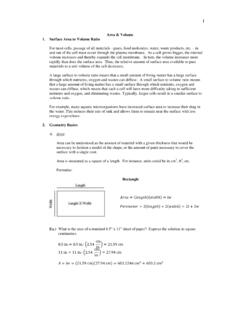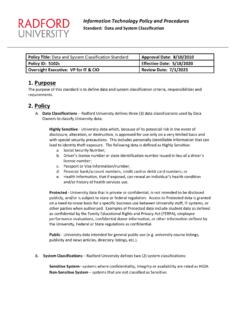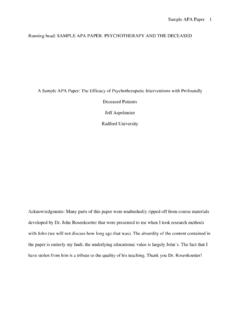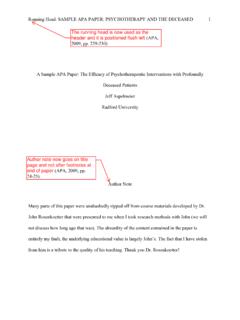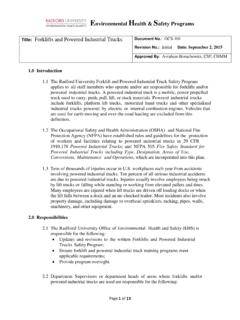Transcription of Transformational Graphing in the Real World
1 Transformational Graphing in the real World I. UNIT OVERVIEW & PURPOSE: This unit specifically addresses the concept of Transformational Graphing . Absolute value, polynomial, and square root functions will be examined. II. UNIT AUTHOR: Donna Deplazes Craig County Public Schools III. COURSE: Mathematical Modeling: Capstone Course IV. CONTENT STRAND: Algebra V. OBJECTIVES: To recognize and translate the graph of an absolute value function. To recognize and translate the graph of polynomial (specifically quadratic) functions. To establish a pattern for easy recognition of higher order polynomials. To recognize and translate the graph of square root function.
2 To expose students to possible real World situations involving Transformational Graphing . VI. MATHEMATICS PERFORMANCE EXPECTATION(s): : Collect and analyze data, determine the equation of the curve of best fit, make predictions, and solve real - World problems, using mathematical models. Mathematical models will include polynomial, exponential, and logarithmic functions. : Transfer between and analyze multiple representations of functions, including algebraic formulas, graphs, tables, and words. Select and use appropriate representations for analysis, interpretation, and prediction. : Recognize the general shape of function (absolute value, square root, cube root, rational, polynomial, exponential, and logarithmic) families and convert between graphic and symbolic forms of functions.
3 A Transformational approach to Graphing will be employed. Graphing calculators will be used as a tool to investigate the shapes and behaviors or these functions. VII. CONTENT: This unit specifically addresses the topic of transformation Graphing and general recognition of absolute value, polynomial (specifically quadratic), and exponential functions. All lessons are discussed in the context of a real World application. VIII. REFERENCE/RESOURCE MATERIALS: Graphing calculators will be required. Student Exploration Worksheets and Exit Slip Assessments will be needed for all three lessons. Computers to access GeoGebra would also be beneficial when presenting if you find or make your own animation applets to help students visualize the concepts.
4 IX. PRIMARY ASSESSMENT STRATEGIES: Please see Exit Slip Assessments attached to each lesson. Upon completion of more functions a unit assessment on the transformation of functions will be given. X. EVALUATION CRITERIA: Students will complete a five question exit slip at the end of the lesson. Documents will be attached to each individual lesson. Students will earn a classwork grade out of 10 points 5 of these points are from the answers to the exit slip, 2 points are for each group s participation in the class discussion, and 3 points are for each student s participation in their group. XI. INSTRUCTIONAL TIME: Three 90-minute class periods.
5 Building Bridges Strand Algebra Mathematical Objective(s) Functions, Quadratic Functions, Transformational Graphing In this lesson students will discuss Transformational Graphing by examining the construction of suspension bridges. Students will explore multiple representations of quadratic functions. They will solve given problems by transforming the graph of a quadratic function. Tables, graphs, and equations will be used by students to aide in finding the necessary solutions. Mathematics Performance Expectation(s) : Collect and analyze data, determine the equation of the curve of best fit, make predictions, and solve real - World problems, using mathematical models.
6 Mathematical models will include polynomial, exponential, and logarithmic functions. : Transfer between and analyze multiple representations of functions, including algebraic formulas, graphs, tables, and words. Select and use appropriate representations for analysis, interpretation, and prediction. : Recognize the general shape of function (absolute value, square root, cube root, rational, polynomial, exponential, and logarithmic) families and convert between graphic and symbolic forms of functions. A Transformational approach to Graphing will be employed. Graphing calculators will be used as a tool to investigate the shapes and behaviors of these functions.
7 Related SOL The student will recognize the general shape of function (quadratic) families and will convert between graphic and symbolic forms of functions. A Transformational approach to Graphing will be employed. Graphing calculators will be used as a tool to investigate the shapes and behaviors of these functions. The student will collect data and generate an equation for the curve (quadratic) of best fit to model real - World problems or applications. Students will use the best fit equation to interpolate function values, make decisions, and justify conclusions with algebraic and/or graphical models. The student will transfer between and analyze multiple representations of functions, including algebraic formulas, graphs, tables, and words.
8 Students will select and use appropriate representations for analysis, interpretation, and prediction. Please note that transformation Graphing will be applied in all lessons within the unit. The type of function addressed will change daily. It is intended for students to use basic transformation Graphing techniques to help them on a day-to-day basis. NCTM Standards Understand relations and functions and select, convert flexibly among, and use various representations for them. Interpret representations of functions of two variables. Use symbolic algebra to represent and explain mathematical relationships.
9 Materials/Resources Classroom set of Graphing calculators. Students need to be familiar with the structure of suspension bridges. Below are a couple of the famous American suspension bridges. o Golden Gate Bridge o Brooklyn Bridge SmartBoard or LCD Projector Building Bridges Student Exploration WS #1 Building Bridges Student Exploration WS #2 Building Bridges Exit Slip Assessment Assumption of Prior Knowledge Students should have completed Algebra II. Students should have experience using a Graphing calculator, specifically finding a specific viewing window. Students might find it difficult to realize that horizontal transformations are represented reversely from graphic to symbolic representation.
10 The relevant real life context in this problem is related to the construction of a suspension bridge. Introduction: Setting Up the Mathematical Task In this lesson, students will investigate how vertical and horizontal translations affect the symbolic representation of a quadratic function. Introduction 20 minutes Student Exploration #1 20 minutes Discussion of SE #1 10 minutes Student Exploration #2 20 minutes Discussion of SE #2 10 minutes CW Assignment: Exit Slip Assessment 10 minutes Have students discuss the similarities and differences between the graphs of absolute value functions and quadratic functions.
